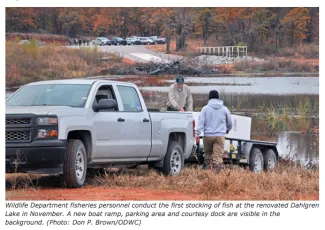A new walk-in hunting and fishing public access program, a partnership with an NBA All-Star, and renovated public shooting ranges are among the many notable accomplishments of the Oklahoma Department of Wildlife Conservation during the past year.

“The Wildlife Department made great strides for our customers in 2017,” Director J.D. Strong said. “Our passion for managing the state’s wildlife resources and habitat to benefit current and future hunters, anglers and others who appreciate wildlife leapt forward in many positive ways.”
The Department fulfills its multiple missions with fewer than 350 employees. It manages the state’s fish and wildlife resources, issues hunting and fishing licenses, provides educational services about the outdoors and recreation, maintains over a million acres of public use areas, and enforces rules and regulations.
“And we meet all of these challenges without the benefit of state tax dollars,” Strong said. “The Wildlife Department operates on a user-pay, everyone-benefits principle, where hunters and anglers fund wildlife conservation with their license fees, which ensures that these important traditions can be passed on to future generations of Oklahomans.”
2017 was a year of notable success stories for the Wildlife Department and its outdoors customers. Near the top of the list was the launch of the Oklahoma Land Access Program, which opened to sportsmen Sept. 1, offering 35,000 acres, 45 pond acres and 2.75 miles of stream access to licensed hunters and anglers in only four short months.
Lands and waters enrolled in OLAP offer walk-in public access while providing incentive payments to the landowners. The program uses more than $2 million in Voluntary Public Access and Habitat Incentive Program grant money provided by the U.S. Department of Agriculture and administered by the Natural Resources Conservation Service to increase public hunting and fishing opportunities. Additional payments have been pledged by Oklahoma Pheasants Forever/Quail Forever if farmers leave standing crops or delay harvest.
OLAP users are responsible for knowing and understanding the rules of the program and of each property. They also must follow the OLAP Code of Conduct. New areas are added throughout the year, while other areas may leave the program. Users are kept up-to- date with online maps. For more information, go to the OLAP page on the Department’s website at www.wildlifedepartment.com.
Other notable 2017 developments from the Wildlife Department include:

PARTNERSHIP WITH PAUL: Oklahoma City Thunder star Paul George loves to fish! The four-time NBA All-Star has been converting friends into fishing fans since his youth.
In November, George gathered with about 45 grade-schoolers along the Oklahoma River to announce a new partnership between his foundation and the Oklahoma Department of Wildlife Conservation. The Paul George Foundation Outdoor Initiative will introduce ODWC’s Fishing in the Schools program to 13 new inner-city schools in Oklahoma City.
George stressed the importance of kids getting outside in an age when their time is dominated largely by video games and technology.
Strong commended PG13 for his commitment to the next generation of Oklahoma outdoor enthusiasts. “We have the most difficult time reaching those inner-city schools and, so, Paul George reaching out to us looking for this partnership opportunity is a perfect opportunity.”
Along with the Department’s other educational programs, Fishing in the Schools continues to grow in popularity, ending 2017 with nearly 350 schools involved statewide.
SHOOTING RANGES: Recognizing that more sportsmen are embracing the shooting sports, the Wildlife Department announced an ambitious plan to renovate about a dozen shooting ranges at wildlife management areas statewide.
At the end of 2017, re-worked ranges at Lexington and Cherokee WMAs had opened. An additional nine shooting ranges are set for renovation in the next five years.
The ranges have separate long-distance and short-distance ranges for rifles and pistols. Shotgun shooting at clay targets is permitted but users must provide their own target throwers.
The renovations are funded in part with grants from the federal Wildlife and Sport Fish Restoration Program. In addition, the National Rifle Association Foundation supported the Lexington WMA project with a $6,000 donation.
NEW WMA: Hunter and angler access got another boost in 2017 with the October opening of Arbuckle Springs Wildlife Management Area in northeastern Johnston County. The area’s 3,869-acre landscape is defined by rocky prairies with native grasses and intermittent streams bordered by post oak and blackjack oak forested areas.
Situated in the foothills of the Arbuckle Mountain range, it is geologically the oldest and has the most diverse suite of mineral resources of all WMAs. While fishing is limited, hunters are able to pursue deer, turkey, dove, quail and furbearers as specified in special area regulations.
HELP AFTER HARVEY: Teams of Oklahoma Game Wardens headed south in early September after Hurricane Harvey barreled ashore near Houston. When they arrived, Game Wardens worked tirelessly for days to help with search and rescue, and relief duties primarily in flooded areas of northwest Houston.
They rescued about 125 people including several from a nursing home; rescued more than 50 animals; transported families with children out of flood areas; and took vital medicines to patients in need.
As certified peace officers, the Game Wardens worked with the U.S. Border Patrol and the Houston Police Department. For many of the Oklahoma officers, their "accommodations" were cots set up in a shopping center parking lot.
NIGHT-SHOOTING SWINE: The Wildlife Department continued working with the Wildlife Services Division of the Oklahoma Department of Agriculture, Food and Forestry to positively address the scourge of invasive feral swine in Oklahoma. ODWC instituted a procedure allowing people to become exempt from hunting regulations that prohibit shooting at night. The goal is to provide landowners relief from feral swine depredation while also protecting wildlife.
Landowners or their designees may obtain an annual night-shooting exemption on the Wildlife Department’s website.
BRUISER BUCKS: In March, the Department held its first “March Rack Madness” event to highlight the Department’s deer management success and recognize state hunters who harvested some tremendous trophy bucks. Attendees presented more than two-dozen deer antler sets (and one pronghorn) for certified measurers to examine and render an official number.
Evidence of Oklahoma’s bumper crop of big bucks was in no short supply. Two notable trophy bucks from the 2016 season came within inches of unseating the state’s top-scoring deer. And a new Cy Curtis state record was set for mule deer by a rack that scored 226 4/8, harvested by Ron Jones of Pryor.
Oklahoma’s bruiser buck outbreak seems to have continued this year, as some racks showing up recently on social media appear to be green-scoring well over 200, with one rumored to have a gross score of 255!
Perhaps there will be a new state record whitetail that shows up at the Department’s 2018 “March Rack Madness” set for March 9.

DAHLGREN DEVELOPMENTS: Improvements were made to several Department fishing lakes during 2017. At Dahlgren Lake in Lexington WMA, most of the improvements were finished by December and the wait for rain and runoff to refill the lake had begun.
Improvements include a new boat ramp, expanded Americans With Disabilities Act-compliant parking area and courtesy dock, revamped and new fishing jetties, and bank slope repairs. Fish habitat structures are in place on the lakebed, and plans are in place to build new access paths around the lake for bank anglers.
Dahlgren Lake attracts more anglers than any other Department fishing lake. Several other Department fishing lakes, including American Horse and Lake Vincent, have been renovated since Fisheries Chief Barry Bolton challenged his staff to make the Department’s fishing lakes the finest fishing areas in Oklahoma. These and similar projects are funded in part with grants from the federal Wildlife and Sport Fish Restoration Program.
NEW AT NANIH WAIYA: Improvements are being made in and around Lake Nanih Waiya in southeastern Oklahoma thanks to an agreement between the Choctaw Nation of Oklahoma and the Wildlife Department.
The lake is among 16 fishing lakes owned by the Department. It was built in 1958 and has 131 surface acres of water.
The Choctaw Nation has agreed to maintain the lake area. The Department may provide training and guidance as well as communicate with the Nation regarding any major improvements. The Department also has sole responsibility for managing wildlife conservation efforts around the lake.
The Department has built new fencing and gates to maintain and protect the dam from premature erosion and control woody vegetation. Visitors will still have access to the dam on foot only.
ALTUS-LUGERT’S RETURN: Last spring, fisheries biologists reported that Lake Altus-Lugert was recovering, and even thriving, as anglers were having good fishing success. This was after several deadly outbreaks of golden alga, the first in 2012, killed nearly every fish in the lake.
Fisheries Chief Barry Bolton said he couldn't be more proud of the biologists and technicians who developed a response plan and put extra emphasis on Altus-Lugert to enable the recovery.
“We’re very pleased that the Altus-Lugert fishery has recovered quickly and again is a fishing destination in southwestern Oklahoma,” Bolton said. “This would not have been possible without the great efforts of the Southwest Region Fisheries personnel who stocked fish, monitored populations and are now seeing the successful results of their efforts.”
With a successful 2017 behind us, your Wildlife Department is anxious to create more exciting opportunities during 2018, and some notable projects are already under way. Among those is an all-new license sales system under development to streamline and simplify the license-buying process for sportsmen and women, helping the Department provide better customer service to the people we serve.